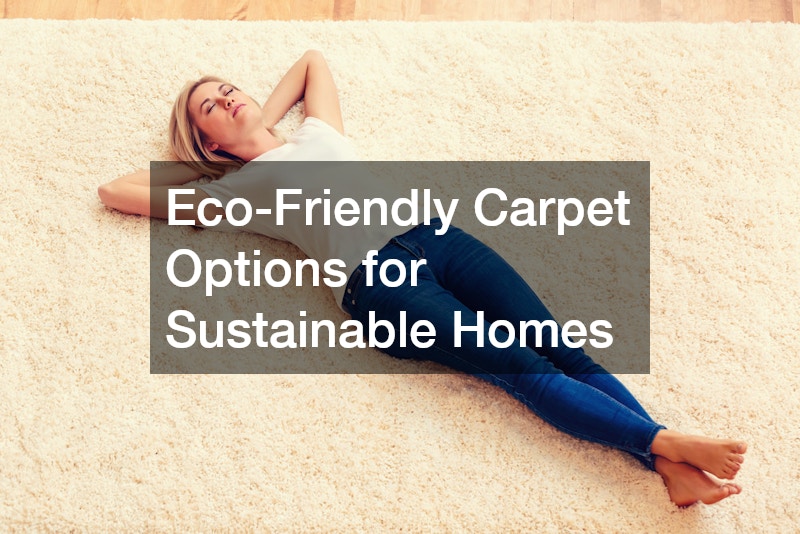Choosing the right carpet is a key decision for homeowners who want to create a stylish and comfortable living space while reducing their environmental impact. Carpets contribute to the look and feel of your home but can also affect indoor air quality and resource use.
Fortunately, the market now offers many eco-friendly carpet options that blend sustainability, durability and aesthetic appeal.
Whether you are renovating an existing home or building a new one, selecting an environmentally responsible carpet helps lower your carbon footprint, reduce waste and improve your household’s health. To make the best choice, it’s important to understand the types of eco-friendly carpets, the materials used and the certifications that guarantee their sustainability.
Natural Fibre Carpets: Renewable and Biodegradable
Natural fibre carpets are made from fibres sourced from plants or animals. These materials are renewable, biodegradable and generally require less chemical processing than synthetic alternatives.
Wool is one of the most popular natural fibres for carpets. It offers excellent resilience and softness, naturally resists fire, and provides good insulation against heat and sound. Wool carpets can last for many years with proper care, making them a durable and sustainable option. Because wool is biodegradable, it breaks down naturally at the end of its life, reducing landfill waste.
Other natural fibres used in carpets include sisal, jute, coir and seagrass. These plant-based fibres bring texture and an organic look to floors. Sisal and jute are hardwearing and ideal for low-traffic areas, while seagrass carpets are naturally water resistant and easy to clean. These fibres generally have a lower environmental footprint during production and are also biodegradable.
However, natural fibre carpets may not be suitable for all areas of the home. They can absorb moisture more readily than synthetic carpets, so they are better suited to dry spaces or those with good ventilation.
Carpets Made from Recycled Materials: Reducing Waste
Another popular eco-friendly carpet choice is products made from recycled materials. These carpets use fibres created from post-consumer plastics such as recycled PET bottles. By converting plastic waste into carpet fibres, these options reduce the amount of plastic sent to landfills or oceans.
Recycled fibre carpets have improved greatly in quality and style. They now offer a range of textures, colours and pile types that suit many interiors. Many recycled carpets are also designed to be durable and stain-resistant, making them practical for busy homes.
When purchasing recycled carpets, look for environmental certifications such as Cradle to Cradle or Green Label Plus. These indicate the carpets have been tested for low emissions of volatile organic compounds (VOCs) and adhere to sustainable manufacturing processes.
Low VOC and Non-Toxic Carpets: Health and Environmental Benefits
Indoor air quality is a major concern for many homeowners. Traditional carpets can off-gas chemicals including formaldehyde, heavy metals and synthetic dyes. Choosing carpets with low VOC emissions and non-toxic materials creates a healthier home environment, especially for children, elderly family members and those with allergies or respiratory conditions.
Eco-friendly carpets often use natural dyes derived from plants or minerals. These dyes avoid harmful chemicals found in conventional carpets and reduce indoor pollution. Many sustainable carpet manufacturers also avoid toxic adhesives and backing materials.
When selecting carpets, check for third-party certifications that verify low VOC emissions and chemical safety. Green certifications provide assurance that the carpet supports better indoor air quality and environmental responsibility.
Durability: A Key Factor in Sustainability
Sustainability involves more than just choosing the right materials. A carpet’s durability greatly affects its overall environmental impact. A long-lasting carpet reduces the need for replacement, thereby saving resources and minimising waste.
High-quality carpets made from wool, recycled fibres or strong natural materials can withstand years of foot traffic without losing their appearance or performance. Choosing carpets designed to resist stains and wear is an important step.
Proper maintenance also extends the life of your carpet. Regular vacuuming, prompt stain removal and periodic professional cleaning keep your floors looking fresh and performing well for longer.
Additional Considerations: Installation and End of Life
When planning your eco-friendly carpet purchase, consider the installation and disposal aspects. Some carpets come with backing materials that are difficult to recycle, so ask suppliers about environmentally responsible installation options.
At the end of its lifespan, a sustainable carpet should ideally be recyclable or biodegradable. Look for manufacturers who offer take-back or recycling programmes to minimise landfill contributions.
Selecting an eco-friendly carpet for your home supports sustainability goals while enhancing your living environment. Natural fibre carpets provide renewable and biodegradable options. Recycled fibre carpets reduce plastic waste and offer a wide range of design choices. Low-VOC and non-toxic carpets protect indoor air quality for healthier living.
Durability and responsible installation are also critical to making a truly sustainable choice. By investing in high-quality carpets and proper maintenance, homeowners can enjoy beautiful, comfortable floors that last.
Consulting with knowledgeable suppliers who specialise in eco-conscious products can help you navigate your options and choose carpets that fit your style, budget and environmental values.
With increasing availability and innovation in sustainable carpet options, creating an environmentally friendly home has never been easier or more attractive.



